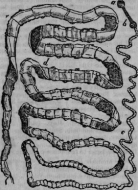 Why are worms important?
Why are worms important?
Worms are internal parasites that affect all species of mammal, including humans. Many types of worms specifically affect certain species of mammal. The types of worms that affect horses are very specific for horses, so humans cannot become infested by the types of worms that affect horses.
Worms can cause a variety of clinical signs ranging from none through to death. Horses with a low worm burden may show no clinical signs. More subtle clinical signs include poor performance or poor growth rate in young horses, through to weight loss, anaemia, diarrhoea, severe colic and acute death. Other clinical signs associated with specific types of worms include coughing and tail rubbing.
Manure samples can be collected and submitted for analysis. The laboratory performs a faecal egg count to determine the number of worm eggs in the manure. This can be used as a guide to the horse’s current worm burden. Unfortunately, the larval stages of a worm’s life cycle can be the most damaging, and these cannot be detected in a faecal sample. However, a high faecal egg count increases the suspicion of worms or larvae being the cause of the horse’s clinical signs, and also indicates that the current worming program is ineffective.
How do horses become infested with worms?
Worms in the gut produce eggs that are passed in the manure onto the pasture. Horses then graze the pasture and ingest the eggs. Once inside the body, the eggs hatch and resume their lifecycle as larvae. This often involves a period of migrating through the tissues, including the guts, lungs and liver, before returning to the gut as an adult, egg-producing worm. This is a basic explanation. Different parasites have slightly different variations on this cycle, but this information is not essential for this article.
What are the types of worms that affect horses?
- Small strongyles/redworms (cyathostomes)
- These are common and cause direct damage to the gut wall. They are the most important class of worms currently as they are responsible for most worm-related illness in horses. In winter the immature stages encyst in the gut wall. When they emerge in spring they can cause colic and diarrhoea due to damage to the gut wall.
- Susceptible to:
- Moxidectin
- 5 day course of fenbendazole at 10mg/kg
- Large strongyles/redworms (e.g. Strongylus vulgaris)
- These can invade the blood vessels in the abdomen and can cause anaemia, colic or sudden death due to rupture of a blood vessel. They used to be a major problem in horses but rarely cause problems nowadays as they are susceptible to the major classes of wormer drugs used.
- Susceptible to:
- Benzimidazoles
- Macrocyclic lactones
- Tapeworms (Anoplocephala perfoliata)
- Can cause colic and death.
- Susceptible to:
- Pyrantel at double the normal dose
- Praziquantel
- Roundworms (Parascaris equorum)
- Affect foals only as immunity develops in older horses resulting in spontaneous expulsion of the worm. They live in the small intestine, and large numbers of them can cause obstruction of the intestine. This usually occurs 1-5 days after the foal is wormed, causing colic. Affected foals are usually 2-6 months of age and unthrifty (poorly grown for their age, possibly underweight, poor hair coat). The worm is susceptible to the common wormers used. If you suspect that your foal may be infested with roundworms and by worming it with a regular wormer you may cause colic, it is best to worm the foal with low-dose fenbendazole (Panacur), a type of benzimidazole, which will kill off some of the worms but not all of them. One week later, worm with the normal dose of fenbendazole to remove the rest of the worms. By worming in two stages, the risk of causing an obstruction is reduced.
- Susceptible to:
- Benzimidazoles
- Macrocyclic lactones
- Threadworm (Strongyloides westeri)
- Adult horses often do not have a patent infection (they do not carry the worm within their gut), but larvae are present in the tissues, where they do not cause a problem. Parturition (giving birth) can stimulate re-activation of these larvae, which migrate to the mare’s udder and infect the milk. The foal drinks the infected milk and becomes infected. This worm is rarely a problem but has been associated with diarrhoea in foals.
- Susceptible to:
- Macrocylic lactones
- Pinworms (Oxyuris equi)
- These worms are not a major problem, but they reside in the anus and can cause irritation around the anus, resulting in the horse rubbing its bottom to try to scratch the itch. This results in the horse rubbing out its tail, which can be a problem in show horses. These worms are very susceptible to most classes of wormer drugs.
- Susceptible to:
- Benzimidazoles
- Macrocyclic lactones
- Lungworm (Dictyocaulus arnfieldi)
- Lungworm is an uncommon problem in horses. Again, this type of worm is very susceptible to most types of wormer drugs. Donkeys often carry the worm without showing any clinical signs, and they are usually the source of infection for horses. In horses it causes a cough, and in extreme cases can cause pneumonia.
- Susceptible to:
- Benzimidazoles
- Macrocyclic lactones
- Bots
- Very common. Flies lay their eggs on the horse’s coat. The horse licks its coat and ingests the eggs, which hatch in the stomach and attach to the lining of the stomach. Can cause ulcers in rare cases. They are not a worm, but for the purpose of this article they will be included as one.
- Susceptible to:
- Macrocyclic lactones
Which Classes of Worming Products are Used in Horses?
- Benzimidazoles
- E.g. fenbendazole and oxfendazole
- Macrocyclic lactones
- E.g. Ivermectin, abamectin and moxidectin
- Praziquantel and pyrantel
The last class of wormers are very effective against certain worm species, but are classed as ‘narrow spectrum’, which means that there are many worm species against which praziquantel and pyrantel are not effective. Therefore, they are not suitable to be used alone as part of your rotational worming program (see later). However, they are often used in combination with the other two classes of wormer, producing ‘broad spectrum’ products that are effective against most, if not all, species of worm. Some commonly used products and their active ingredients are listed below:
|
Product name |
Active ingredient(s) |
|
Panacur |
Fenbendazole |
|
Strategy-T |
Oxfendazole and pyrantel |
|
Equimec |
Ivermectin |
|
Equimax |
Abamectin and praziquantel |
|
Equest plus tape |
Moxidectin and praziquantel |
|
Ammo |
Abamectin and morantel (like pyrantel) |
What is a suitable worming program for my horse?
Mares should be wormed approximately 4 weeks prior to foaling and again the day after foaling with a macrocyclic lactone to remove any threadworms. Foals can begin to be wormed from approximately 4-6 weeks of age. Always check that the product you buy is safe to use in foals. Foals often require more frequent worming than adults, but check the information on the tube of wormer to check how often the manufacturer recommends worming the foal, as it can vary between products.
It is important to rotate the wormer you use, in both foals and adults, to minimise the development of resistance. Most people advise that in year one use one group of wormer every 6-8 weeks (e.g. macrocyclic lactone for year one), then use a different wormer group for year two (e.g. a benzimidazole for year two). Check how often the manufacturer recommends using the product by reading the label. Some people advise using pyrantel/praziquantel for the third year, but these are not as broad spectrum in their activity as the macrocyclic lactones and benzimidazoles, so it may be more advisable to go back to the year one wormer. If the wormer you are using contains moxidectin (Equest plus tape), then this needs to be used only every 14-16 weeks as it has a longer effective period. Ensure that when you change your wormer each year, you change the class of wormer (the active ingredients in the two major classes end in either -ectin or –azole) and not just the brand name.
At certain times of the year it is important to treat the horse for specific worms. Bots should be treated for in mid-late summer and mid-late winter (macrocyclic lactones are effective). It would be wise to also remove any bot eggs present on the horse’s coat at the same time as treating for bots.
The best time of year to treat for tapeworms is autumn, and remember to use double-dose pyrantel or use praziquantel. Therefore, if you are using Equest plus tape as your standard wormer for the year, make sure one of your treatments falls in autumn in order to target the tapeworms. Autumn is also a good time to treat encysted larvae of the small redworms (cyathostomes); they are susceptible to either moxidectin or a five-day course of fenbendazole. Therefore, dosing your horse with Equest plus tape in autumn should target both tapeworms and encysted cyathostomes.
What is worm resistance?
Drugs used to kill worms and remove them from the body rely on the worm being susceptible to that drug. For a variety of reasons, worms are able to become resistant to drugs used against them, so that they are no longer killed by that drug. Misuse and overuse of wormers are the main reasons for the development of resistance among target worm populations. Research is constantly being carried out to develop new wormers that do not have any resistance problems, but this takes a lot of time and money. In order to reduce the rate at which resistance develops, to ensure the population of worms remains susceptible to the drugs currently available, so that we can protect our horses from problems associated with worm infestations, there are a number of actions that can be taken, such as:
- Use an effective product
- The following link is to the NSW DPI website. At the bottom of the page click on the link that opens up the ‘primefacts’ sheet. At the end is a comprehensive table showing most of the worming products on the market, their active ingredients and which worms they are effective against.
- http://www.dpi.nsw.gov.au/agriculture/livestock/horses/health/general/worm-control
- Use the correct dose
- Under-dosing is a major cause of the development of worm resistance
- Use a measuring tape to estimate your horse’s weight, or consult your veterinarian
- Ensure the horse receives the full dose, and does not spit out any of the wormer after it has been given
- Use combination products (e.g. Strategy-T Paste contains a combination of oxfendazole and pyrantel, drugs from two different classes)
- Rotate the class of worming drug used on an annual basis, as described above
- Use the minimum number of treatments necessary to maintain an adequate worming program
- Use appropriate products depending upon the time of year (e.g. for tapeworms use Equest plus tape in autumn)
- Perform regular faecal egg counts to ensure your worming program is effective
- If the horse has a low faecal egg count, it may be possible to skip the next scheduled worming
- Supplement your worming program with other control strategies, see below
Tips to Maximise Your Worm Control Program
- Remove manure from pastures regularly (at least weekly)
- Feed horses in feed bins, preferably off the ground
- Keep stocking rates as low as possible
- Segregate horses according to age, and keep the youngest horses on the least contaminated pasture
- Drench all horses in a group at the same time
- Mixed grazing with sheep or cattle or prolonged spelling of pasture can help to reduce contamination
Drench all new horses before they enter the property, and wait 48 hours before introducing them to pasture, to reduce the risk of introducing resistant worm species onto the property









